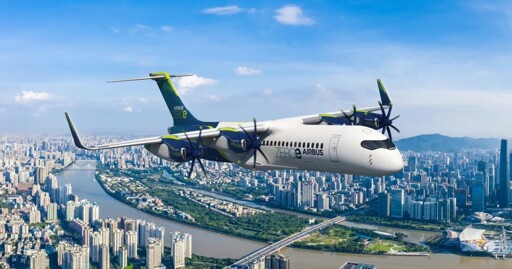Wait aren’t all airplane wings bid inspired?
Plot twist: And they’ll stick pack their passengers like sardines.
Wait, so what has been inspiring wings up to this?
Bumble bees.
Aviation peaked with the Spruce Goose, AKA the Birch Bitch, AKA the H-4 Hercules. Been downhill ever since…

Higher for hire

Ohh ee ohh!
Hell yeah the wood plane
Never heard it called the birch bitch.
So not the picture in the thumbnail but a generic jet
Airbus explained that it ran the numbers and found that, while it could build a successful hydrogen airliner, the plane would be successful in the same way that Concorde was successful. In other words, a technological triumph, but a commercial failure.
Just like any other hydrogen powered… Anything.
It’s because hydrogen is a terrible fuel. In theory it could work, but there were so many practical problems with compressing the hydrogen into storage tanks and then keeping it in those storage tanks but the amount of effort you have to go through to make it work completely negates any performance benefits.
But its only exhaust is PuRe wATeR!! /s
It still makes me LOL to see people tout this, when battery EVs don’t exhaust anything.
Alas, battery EV passenger jets are a long way off.
It’s true, but so is retooling aviation around hydrogen. This is just a prediction but I think before that ever happens, EITHER we’ll have light batteries that are safer and more effective that Lithium OR we’ll have carbon-neutral ways to produce hydrocarbon fuels that can be used with conventional aircraft.
Hydrogen has struck out on personal electronics and ground transportation. Now it’s angling for aviation where its energy density may matter more. But it hasn’t been losing because of energy density.
They are without significant improvements in battery technology. Lithium Ion simply doesn’t have the energy density to be able to lift its own weight.
There’s also the fact that they are too explosive to conform to flight safety standards.
Well I mean so it is kerosene technically
also most hydrogen now is not green at all, the production of it uses methane and releases CO2. only a small percent of hydrogen is truly green, and very expensive.
…then there should be regulatory actions to help make them viable
Subsidising an inherently flawed technology isn’t the way to go.
What are the other 0 carbon flight options? They are all flawed.
We can engineer our way through flaws with enough effort though.
Yes, but hydrogen has significantly more flaws than most other options. It’s been around for 50 years, has never been a commercial success, and just inherently kinda sucks.
Electricity has been around that long too though, yet there are no serious electric passenger planes (with a decent range)
It has it’s flaws, but it may have a higher ceiling in terms of usefulness. They say they can make it work, which is more than I hear about electric planes for example.
We should be financially encouraging 0 carbon planes, without controlling how, then let the engineers work what tech to do it with.
You can also run an aircraft on biofuel with little to no modifications, with none of the downsides of hydrogen.
I take from that, that we will only get technological breakthroughs away from oil after we break everything down and rebuild from scratch. Because the economy that allowed setting up fuel infrastructure a century ago, is now a much tighter fit.
It’s more that Hydrogen is an inherently shit way of powering a vehicle, and liquid fuels are much easier to store and transport.
Biofuels are a much better option, in my view.
To me “next generation” and propellers just don’t mix, but I know nothing. Just want my jetpack.
I guess this is why so many boeing airplanes have been falling out the sky nowadays. They forgot and accidentally based their aiplanes on land dwelling vetrebrates.
Lol.
Lead engineer: “oh did you say bird, okay I thought you said bear.”
I think it was a bee. After all everyone knows that bees can’t fly.
How many blades do you have to add to a turboprop before it’s promoted to an open turbofan and touted as a major new innovation?
Based on my image search engineering, the answer to your question is 2.
Based on my one semester of air breathing propulsion that I took 25 years ago, I’m guessing there is more going on inside the turbine part of the engine that both allows sustainable fuels that current turbofans can’t and also allows compression ratios at lower fan speeds that allows an open fan with fewer blades. Again, I barely passed air breathing propulsion back then and haven’t used ANY of that knowledge since, so I’m mostly talking out of my ass.
I’ve seen turboprops in museums and on the internet with around six or eight blades. When I looked on the Wikipedia page for propfan engines, which seems to be another name for an open turbofan, the distinction seemed to be mainly how the blades were shaped (like propellor blades or turbine blades) and how tightly-integrated everything is (you can swap the propeller out on a turboprop).
I don’t think the number of blades is really important. After all if you just keep adding blades eventually you would get to a point of diminishing returns. That’s around four blades which is why most only have four blades, unless they’re made out of incredibly light material.
So if you have a lot of extra blades there probably is some additional engineering going on to make use of those extra blades in some way.
I was meaning that the blade count and detachability was the difference in definition between turboprop and propfan/open turbofan, not that it was necessarily the thing making the engine more efficient.
Rocket designs are worm(-with-diarrhea)-inspired!!
That’s a great description!
Thank you.
I much prefer it to the crude ‘flying cocks’ one.
deleted by creator






